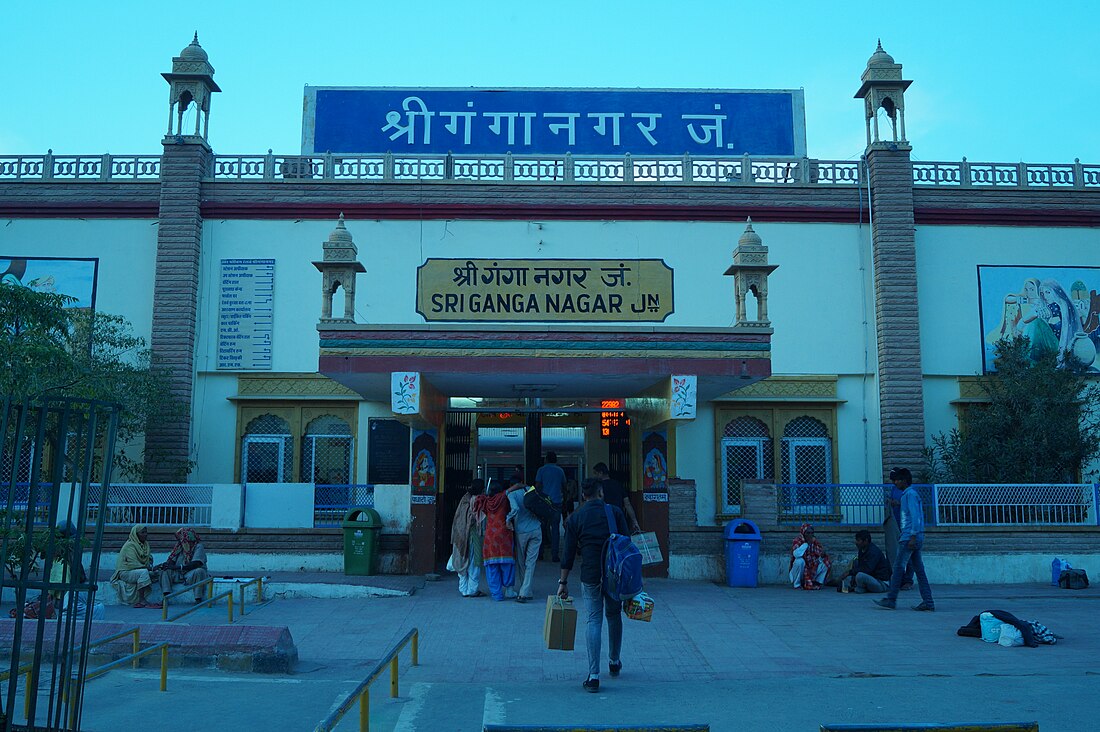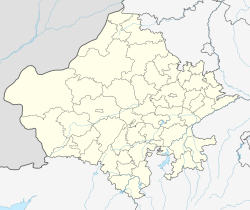Top Qs
Timeline
Chat
Perspective
Sri Ganganagar
City in Rajasthan, India From Wikipedia, the free encyclopedia
Remove ads
Sri Ganganagar is the northernmost city of the Indian state of Rajasthan, near the international border of India and Pakistan. It is the administrative headquarters of Sri Ganganagar district. It is named after Ganga Singh, Maharaja of Bikaner.[3]
This article has multiple issues. Please help improve it or discuss these issues on the talk page. (Learn how and when to remove these messages)
|
Remove ads
History
Summarize
Perspective

Sri Ganganagar was established by Maharaja Ganga Singh. It was part of the Bikaner princely state.[4] Sri Ganganagar is one of the first well-planned modern cities of India. It is divided into residential blocks and a commercial area which includes an agricultural marketplace.
It is located at the point where the Sutlej River enters Rajasthan and the former Bikaner State. This area first came under the jurisdiction of Bahawalpur state, but the area was unguarded, and Hindu Mal, a companion of Maharaja Ganga Singh, took advantage of this opportunity and moved the posts along the boundary. He started his journey to change posts from Suratgarh in the south, and went until what is now Hindumalkot in the north. He informed the Maharaja about his successful invasion of the area when he reached the northern part and thereafter died, giving name to the city Hindumalkot.
From 1899 to 1900, the Bikaner State was affected by a severe famine. To resolve this issue, Maharaja Ganga Singh obtained the services of AWE Standley, an engineer, who demonstrated the feasibility of the western area of the Bikaner State being irrigated by the waters of the Sutlej. The plan of the Sutlej Valley Project was drawn by the chief engineer of Punjab, RG Kennedy, according to which the vast area of the Bikaner State could be irrigated. However, the project was delayed due to objections by the state of Bahawalpur.
With the intervention of the Viceroy of India, Lord Curzon in 1906, a Tripartite Conference was held and an agreement was reached on 4 September 1920. The foundation stone of the Canal Head Works at Ferozepur was laid on 5 December 1925 and the work completed in 1927 by constructing 143 km (89 mi) of lined canal. The opening ceremony was performed on 26 October 1927 by Lord Irwin, then Viceroy of India.
The plan for the city of Sri Ganganagar was drawn at this time. Irrigated parts of Bikaner State were brought under Sri Ganganagar district. Part of the district was later split off to form Hanumangarh district in 1994. Another part was split off to form Anupgarh district in 2023.
Remove ads
Geography
Summarize
Perspective
Location and area
Sri Ganganagar District is between latitudes 28.4 and 30.6 and longitudes 72.2 and 75.3[5] The total area of Sri Ganganagar is 11,154.66 km2 (1,115,466 ha; 4,306.84 sq mi). It is surrounded on the east by Hanumangarh district, (formerly part of Sri Ganganagar district) on the south west by Anupgarh district, (formerly part of Sri Ganganagar district) on the south by Bikaner District, on the west by Bahawalnagar district of the Pakistani Punjab, and on the north by Fazilka district of Indian Punjab.
Topography

Indira Gandhi Canal, the largest canal in India, is located in Sri Ganganagar district.


Although Sri Ganganagar district lies in the Thar Desert, irrigation via the Indira Gandhi and Ganga Canals has changed the flora and fauna. The district can be classified into five geographical regions:
- The region irrigated by the Ganga Canal and the Bhakra canal tributaries: the northern region, which is 3/4 of the district, resembles the fertile plains of Punjab. Some areas, like the area between the towns of Raisinghnagar and Vijaynagar, have desert-like conditions.
Climate
Remove ads
Demographics
According to the 2011 census Sri Ganganagar city and outgrowths had a population of 237,780.[11][1] Ganganagar had a sex ratio of 859 females for every 1000 males. Males constitute 53.8% of the population and females 46.2%. Ganganagar had an effective literacy rate of 74.25%: male literacy is 88.03%, and female literacy is 76.23%. In Ganganagar, 19.6% of the population is under 6 years of age.[1]
Religion
The majority of the population is Hindu, followed by Sikh and Muslim.[11]
Languages
Hindi and English serve as official languages of the city. Punjabi, Hindi, Rajasthani and Bagri are the most commonly spoken languages.[12][13]
Government and politics
- Member of Parliament: Kuldeep Indora, Indian National Congress.[14]
- Member of Legislative Assembly: Jaydeep Bihani, Bhartiya Janta Party.[15]
Economy
Summarize
Perspective



Desert land was converted to a green town by the efforts of Maharaja Ganga Singh, who brought the Ganga Canal. It carries the excess waters of Punjab and Himachal Pradesh to the region.
The economy of the city is based on agriculture; its main crops are wheat, mustard and cotton. Other crops include guar, bajra, sugar cane and grams. In recent years, farmers are diverting towards horticulture. Kinnow (a citrus family fruit or a hybrid citrus fruit) is a popular horticultural product; other fruits of the citrus family are also grown. The city also have the largest carrot market of Rajasthan.
Industries in Sri Ganganagar District are based on agriculture. Major industries are cotton ginning and pressing factories, mustard oil mills, wheat flour mills, and sugar mills.[16] (known for its Royal Heritage Liqueurs),[17][18]
Tourist attractions
- Bror Village: Ruins of the Indus Valley Civilisation are found here. It is on Anoopgarh-Ramsinghpur road.
- Anoopgarh Fort is a ruin in the city of Anoopgarh. It was built by Anoop Singh Rathore.
- The Hindumalkot Border, the Indo-Pak Border, derives its name from Hindumal, the Diwan of Bikaner. This international border is 31.8 km (19.8 mi) away and is just a 45 minutes drive from Sri Ganganagar, Pakistan's Observation Post can be seen from this site.
- Vakilon Wali Diggi (D- Block Diggi) - From this place one can see, a shrine of Sikh religion - Gurudwara Namdev Bhawan, a shrine of Hindu's, Krishna Mandir devoted to Lord Krishna and A mosque, place where Muslims worship.
Temples and places for worship


Rojhri Dham is a complex of religious sites dedicated to the worship of the Hindu deity Hanuman. Dham attracts local worshipers throughout the year. On Chaitra Purnima and Ashvin Purnima every year, large jagrans are organised, where thousands of people assemble to pay homage to the deity. Hanuman Sewa Samiti manages the temple and jagrans. The temple of Hanuman is on the right side of Anupgarh-Bikaner road, about one kilometre from Rojhri Village. It is approximately 55 km (34 mi) from Anupgarh, 22 km (14 mi) from Rawla Mandi, 17 km (11 mi) from Chhatargarh and 185 km (115 mi) south-west of Sri Ganganagar.
Remove ads
Transport
By road

Sri Ganganagar is well connected with road and is linked directly to Delhi, Jaipur, Ludhiana, Chandigarh, Sikar, Karnal, Haridwar, Bathinda, Ambala, Jodhpur and many other cities. National Highway 62 passes through Sri Ganganagar. Auto rickshaws and cycle rickshaws are majorly used for local transport in Sri Ganganagar.
By rail
Sri Ganganagar Junction railway station is a main railway station in Sri Ganganagar District. The city is directly connected to Delhi, Jaipur, Kota, Bikaner, Haridwar, Hanumangarh, Jodhpur, Ambala, Sikar, Bathinda, Firozpur, Fazilka, Howrah, Trivandrum, Nanded, Ahmedabad, Pune, Roorkee, Kanpur, Bangalore and some other cities via train.
By air
Lalgarh Airport is a main airport in Sri Ganganagar District.
Remove ads
Education
Notable people
- Iqbal Singh Chahal, Municipal commissioner and administrator of Brihanmumbai Municipal Corporation
- Avtar Singh Cheema, First Indian to climb Mount Everest
- Ravinder Kaushik, former Research and Analysis Wing agent
- Shahid Mallya, Bollywood playback singer
- Major Rajasthani, Punjabi language singer
- Shyam Rangeela, comedian and politician
- Sohum Shah, Actor, Entrepreneur, was born in Sri Ganganagar
- Jagdeep Sidhu, Indian film director
- Jagjit Singh, Ghazal singer, was born in Sri Ganganagar
Remove ads
References
Wikiwand - on
Seamless Wikipedia browsing. On steroids.
Remove ads



